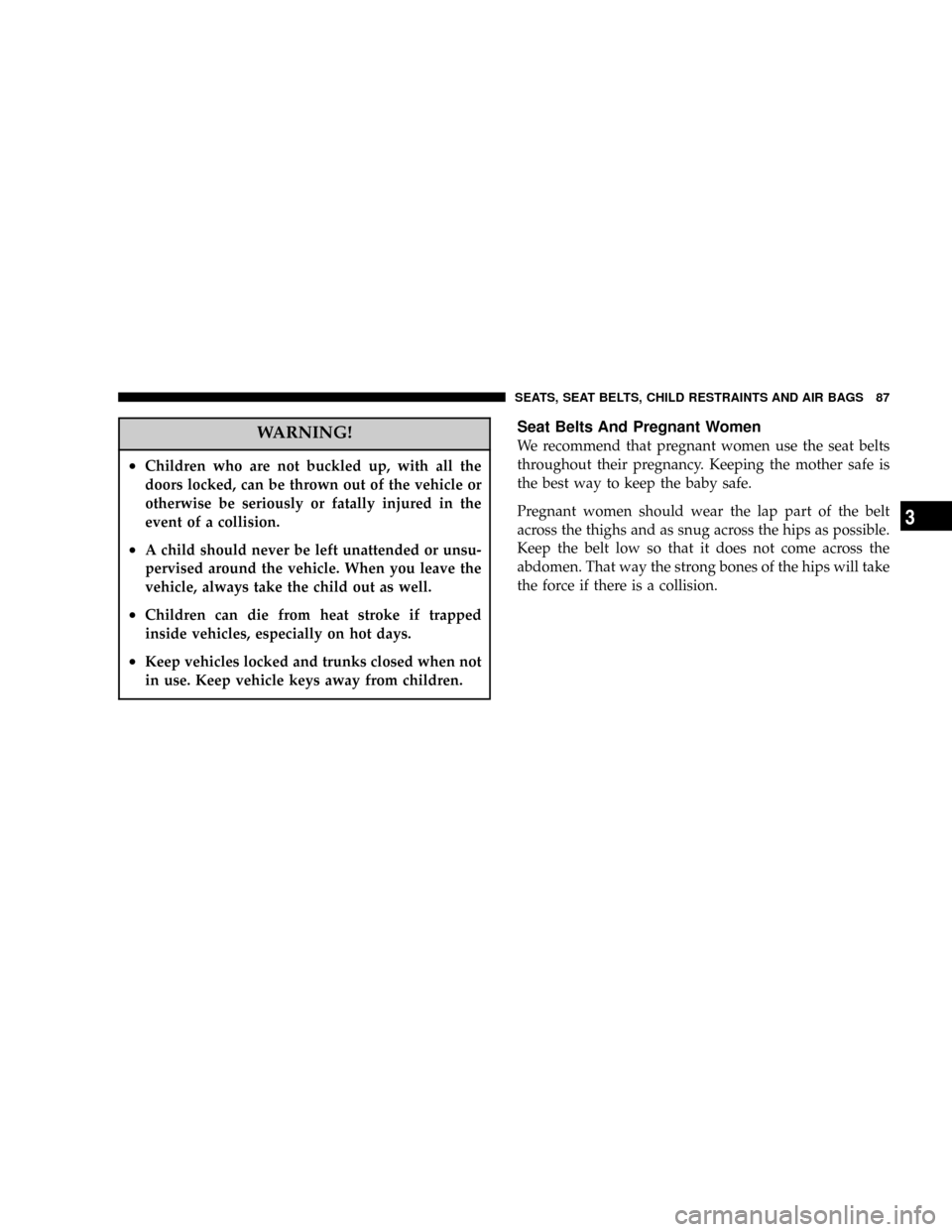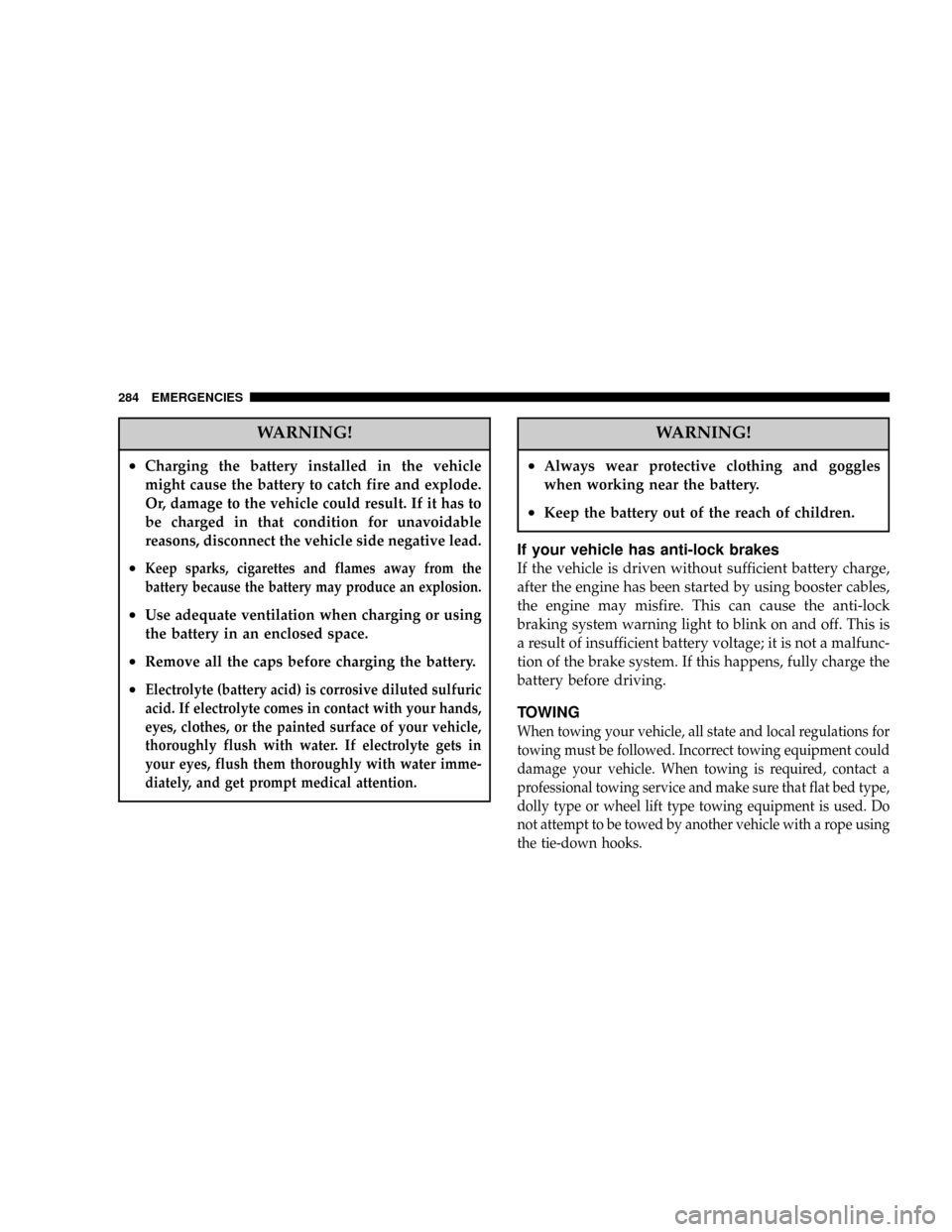2005 DODGE STRATUS COUPE child lock
[x] Cancel search: child lockPage 82 of 396

WARNING!
²If there is any foreign material in or around the
lower anchorage connectors, remove it before in-
stalling the child restraint system. Also, make sure
the seat belt is away from, not looped through or
otherwise interfering with the child restraint sys-
tem. If foreign matter is not removed and/or the
seat belt interferes with the child restraint system,
the child restraint system will not be secured
properly and could detach and move forward in
the event of sudden braking or a collision, seri-
ously injuring the child and possible other vehicle
occupants.
²When the vehicle is moving, do not adjust the seat
where the child restraint system is installed.
Installing a child restraint system to a UNIBELT
at the rear seat positions or the front passenger
seat (With emergency/automatic locking
mechanism)
The UNIBELT at the rear seat positions, and at the front
passenger seat, can be converted from normal Emergency
Locking retractor (ELR) mode, to Automatic Locking
Retractor (ALR) mode. It must be converted to the ALR
mode when installing a child restraint system.
G18C0790
82 SEATS, SEAT BELTS, CHILD RESTRAINTS AND AIR BAGS
Page 84 of 396

3. To activate the ALR mode, slowly pull the shoulder
part of the belt all the way out until it stops, then let the
belt feed back into the retractor.
4. After the belt has retracted, tug on it. If the belt is
locked, you will not be able to pull it out. If you can pull
the belt out, it is not locked and not in the ALR mode. You
will need to repeat steps 3 and 4.5. After confirming that the belt is locked, grab the
shoulder part of the belt near the buckle and pull up to
remove any slack from the lap part of the belt. Remem-
ber, if the lap part of the belt is not tight, the child
restraint system will not be secure. It may help to put
weight on the child restraint system and/or push on its
seatback while pulling up on the belt (see illustration).
G18C0550G18C0560
84 SEATS, SEAT BELTS, CHILD RESTRAINTS AND AIR BAGS
Page 87 of 396

WARNING!
²Children who are not buckled up, with all the
doors locked, can be thrown out of the vehicle or
otherwise be seriously or fatally injured in the
event of a collision.
²A child should never be left unattended or unsu-
pervised around the vehicle. When you leave the
vehicle, always take the child out as well.
²Children can die from heat stroke if trapped
inside vehicles, especially on hot days.
²Keep vehicles locked and trunks closed when not
in use. Keep vehicle keys away from children.
Seat Belts And Pregnant Women
We recommend that pregnant women use the seat belts
throughout their pregnancy. Keeping the mother safe is
the best way to keep the baby safe.
Pregnant women should wear the lap part of the belt
across the thighs and as snug across the hips as possible.
Keep the belt low so that it does not come across the
abdomen. That way the strong bones of the hips will take
the force if there is a collision.
SEATS, SEAT BELTS, CHILD RESTRAINTS AND AIR BAGS 87
3
Page 88 of 396

MAINTENANCE AND INSPECTION OF SEAT
BELTS
The seat belt webbing may be cleaned with mild soap or
detergent solution. Allow the belts to dry in the shade.
Do not allow them to retract until completely dry. Do not
attempt to bleach or re-dye belts. The color may rub off
and webbing strength could be affected.
Regularly check seat belt buckles and release mecha-
nisms for positive action and the retractors when in the
automatic locking retractor mode for positive engage-
ment. Refer to ªInstalling a child restraint system to a
UNIBELTº on page 82.
Check that the anchor mounting bolts are tight. If the seat
belt webbing shows obvious cuts, tears, protruding bro-
ken fibers that cause a local increase in webbing thick-
ness, or severe fading which indicates weakening by
exposure to sunlight, the entire seat belt assembly should
be replaced.The lap belt portion of the front UNIBELT has a sleeve
inside which the belt is folded back over itself in a loop.
This allows the belt to help absorb the energy of a
collision through a controlled release of the loop. In the
event that the loop inside the sleeve has come loose,
replace the entire seat belt assembly.
G28A0420
Good
No GoodSleeve
Sleeve
88 SEATS, SEAT BELTS, CHILD RESTRAINTS AND AIR BAGS
Page 201 of 396

8. Stop driving the vehicle if you think the performance
is noticeably less, or that there is unnecessary engine
miss, or any other engine trouble, such as with the
ignition, etc. If it is impractical to stop driving immedi-
ately, reduce the speed and drive for only a short time.
Have an inspection made by an authorized dealer as
soon as possible.
9. In an unusual event of a severe engine malfunction, a
scorching odor may indicate severe and abnormal cata-
lytic converter overheating. If this occurs, the vehicle
should be stopped in a safe place, the engine shut off and
the vehicle allowed to cool. Once the engine is cool, the
vehicle should immediately be taken to a dealer for
service.
VEHICLE PREPARATION BEFORE DRIVING
Before starting on a trip, perform the following checks to
obtain the greatest possible enjoyment and safety from
your vehicle:
Seat belts and seats
1. Before starting the vehicle, make certain that you and
all your passengers are seated and properly wearing the
seat belts (with children in the rear seat, in appropriate
restraints), and that all doors are locked.
2.
Adjust the driver's seat as far back as possible, while still
maintaining good visibility, and good control of the steering
wheel, brakes, accelerator, and controls. Examine the instru-
ment panel indicators for any possible malfunction.
3. Have the front passenger adjust their seat as far
rearward as possible.
Defrosters
Check operation by selecting the defroster mode and set
the blower switch for high speed operation. You should
be able to feel the air directed against the windshield.
(See ªHeater /Air conditioningº page 238.)
Tires
Examine all tires for excessive tread wear or uneven wear
patterns. Check for stones, nails, glass, or other objects
lodged in the tread. Inspect for tread cuts or sidewall
cracks.
STARTING AND DRIVING 201
5
Page 284 of 396

WARNING!
²Charging the battery installed in the vehicle
might cause the battery to catch fire and explode.
Or, damage to the vehicle could result. If it has to
be charged in that condition for unavoidable
reasons, disconnect the vehicle side negative lead.
²Keep sparks, cigarettes and flames away from the
battery because the battery may produce an explosion.
²Use adequate ventilation when charging or using
the battery in an enclosed space.
²Remove all the caps before charging the battery.
²Electrolyte (battery acid) is corrosive diluted sulfuric
acid. If electrolyte comes in contact with your hands,
eyes, clothes, or the painted surface of your vehicle,
thoroughly flush with water. If electrolyte gets in
your eyes, flush them thoroughly with water imme-
diately, and get prompt medical attention.
WARNING!
²Always wear protective clothing and goggles
when working near the battery.
²Keep the battery out of the reach of children.
If your vehicle has anti-lock brakes
If the vehicle is driven without sufficient battery charge,
after the engine has been started by using booster cables,
the engine may misfire. This can cause the anti-lock
braking system warning light to blink on and off. This is
a result of insufficient battery voltage; it is not a malfunc-
tion of the brake system. If this happens, fully charge the
battery before driving.
TOWING
When towing your vehicle, all state and local regulations for
towing must be followed. Incorrect towing equipment could
damage your vehicle. When towing is required, contact a
professional towing service and make sure that flat bed type,
dolly type or wheel lift type towing equipment is used. Do
not attempt to be towed by another vehicle with a rope using
the tie-down hooks.
284 EMERGENCIES
Page 391 of 396

Cassette Tape and Player Maintenance....... 226
Cassette Tape Player..................221,223
CD Player.........................221,229
Center console......................... 217
Center console box...................... 215
Charging system warning light..........109,116
Check engine/malfunction indicator lamp . 109,117
Child restraint.......................... 76
Clean Air Gasoline...................... 147
Cleaning
Exterior of your car................... 254
Interior of your car.................... 253
Clock................................ 218
Compact spare tire...................267,375
Contract, Service....................... 382
Coolant (engine)....................... 322
Cruise control (for non-turbo)
Indicator.........................109,115
Cruise control (for turbo)
Indicator.........................109,115
Cup holder........................... 214
Customer Arbitration Board............... 383
Customer Assistance.................... 380Dealer Service......................... 380
Defroster (rear window).................. 127
Diagnostic System, Onboard............... 314
Dimmer control........................ 124
Disc brake pads........................ 331
Dome light........................... 306
Dome light/Reading light................ 131
Door hinges, rear hatch hinges, hood lock
release mechanism and safety catch......... 332
Door Opener, Garage.................... 134
Door-ajar warning light...............109,114
Doors
Lock............................... 26
Power door locks...................... 34
Drive belt............................ 335
Driving, alcohol and drugs................ 203
Driving speed
Automatic transaxle................... 159
Manual transaxle..................... 171
Electric rear window defroster switch........ 127
Emission-control system maintenance........ 313
Engine compartment.................259,311
INDEX 391
Page 394 of 396

Odometer..........................108,112
Oil pressure gauge...................... 108
Oil pressure warning light.............109,116
Oil
Engine oil........................... 318
Onboard Diagnostic System............... 314
Opener, Garage Door.................... 134
Operation during cold weather............. 204
Operation under adverse driving conditions . . . 263
Overdrive indicator..................... 109
Oversize tires.......................... 342
Owner 's Manual....................... 385
Parking brake
Operating method.................... 171
Parking brake lever stroke.............. 334
Polishing............................. 258
Power brakes.......................... 174
Power door locks........................ 34
Power windows......................... 44
Proper shift points...................... 169
Puncture (tire changing).................. 274Radial ply tires........................ 341
Radiator cap..................... 311,322,323
Radio................................ 221
General information................... 218
Reading lamps......................... 133
Reading light.......................... 133
Rear seats............................. 66
Rear window defroster................... 127
Replacement of light bulbs................ 293
Reporting Safety Defects................. 383
Safe driving techniques.................. 202
Scheduled maintenance.................. 349
Seat belt extender....................... 75
Seat Belts
Adjustable seat belt anchor.............73,80
And Pregnant Women.................. 87
Child restraint........................ 76
Maintenance and inspection.............. 88
Seat belt extender...................... 75
Seat belt reminder/warning light......... 109
UNIBELT restraint system............... 69
Seatback.............................. 60
394 INDEX